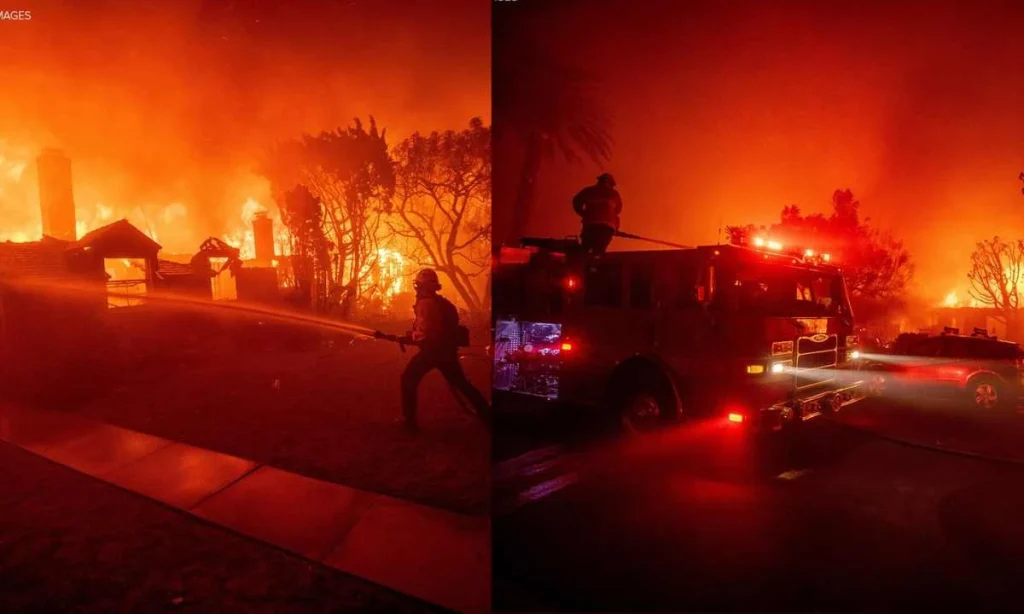Wildfire Erupts In Los Angeles | Thousands of People Forced To Run Abandoning Their Homes and Cars!
A fast-moving wildfire has engulfed an area of Los Angeles, destroying plenty of homes of the wealthy. The fire, which started on Tuesday afternoon, grew from 300 acres to over 1,200 acres in just 90 minutes. California Governor, Gavin Newsom has issued a state of emergency as it has now spread for over 2,900 acres in just one hour. Fueled by strong Santa Ana winds with gusts reaching up to 100 mph, it has forced thousands of residents to flee their homes. People have abandoned their cars and belongings in their rush to escape. Traffic jams stretched across Sunset Boulevard, with some people resorting to fleeing on foot.
This devastating event has threatened neighborhoods like the Pacific Palisades, known for its celebrity residents, and landmarks like the Getty Villa Museum. The fires are expected to get worse overnight as the winds will only become stronger and more intense. Let’s have a closer look at what we know so far.
Overview of the Event
The wildfire began as a small blaze but quickly expanded due to extreme weather conditions. Officials reported that 30,000 people were evacuated from areas near Santa Monica and Malibu, with more than 25,000 residents and 10,000 homes under threat. People with horses also in the Altadena-Pasadena area try to escape the fire in Eaton, Los Angeles County. The Eaton Fire has also forced evacuations and the schools in the area are also shut down temporarily.
Los Angeles Fire Chief Kristin Crowley noted, “We feel very blessed at this point that there are no injuries that are reported.” Meanwhile, Governor Gavin Newsom declared a state of emergency, emphasizing that California’s fire season is now year-round.

Eyewitnesses painted a harrowing picture. Marsha Horowitz, a local resident, recalled being told to leave her car and run: “The fire was right up against the cars.” Actor Steve Guttenberg added, “It’s really important for everybody to band together. Just get out.”
Why The Fire Spread So Quickly
Weather Conditions
The Santa Ana winds, infamous for their dry and powerful gusts, played a significant role in spreading the fire. These winds, combined with low humidity levels of around 17% and dry vegetation due to prolonged drought, created the perfect storm for wildfire growth.
Geographic and Seasonal Context
The fire affected scenic areas like Topanga Canyon and the Pacific Ocean coastline, where narrow roads made evacuation difficult. Governor Newsom remarked, “This time of year traditionally has not been fire season, but now, we disabuse any notion that there is a season. It’s year-round in the state of California.”
Human Impact: Celebrities Also Flee
Evacuation Experiences
Actor James Woods shared on social media, “We were able to evacuate successfully. I do not know at this moment if our home is still standing, but sadly houses on our little street are not.” Eugene Levy described seeing “black and intense smoke” while stuck in evacuation traffic.
Residents left behind cherished belongings as they raced to safety. Roads were jammed with abandoned vehicles, leaving some residents to flee on foot. The emotional toll was evident in Steve Guttenberg’s plea: “Don’t worry about your personal property. Just get out.”
Celebrity Evacuations
The Pacific Palisades, home to many Hollywood stars, has drawn national attention to the crisis. Actor Eugene Levy, James Woods, and others expressed gratitude for being able to evacuate safely, though uncertainty loomed over the fate of their homes.
Community and Emergency Response
Firefighters worked tirelessly, using aircraft to scoop water from the ocean and drop it on the flames. Bulldozers were used to clear abandoned vehicles, allowing emergency teams to navigate the area.
Governor Newsom highlighted the state’s preparedness: “We positioned personnel, firetrucks, and aircraft across Southern California because of the fire danger to the wider region. Hopefully, we’re wrong, but we’re anticipating other fires happening concurrently.”

Air Quality Worsens
The wildfire has also impacted air quality, with smoke posing significant health risks. Local authorities advised residents to wear masks and set their car air-conditioning to recirculate to prevent smoke from entering.
Reporters covering the blaze wore face masks and goggles as the air became harder to breathe. Although the greater Los Angeles area hasn’t seen widespread air quality issues yet, localized spikes near the fire have been detected.
Government and State Response
Emergency Declarations
Governor Newsom’s state of emergency declaration allowed for the mobilization of resources and coordination between local, state, and federal agencies. His statement underscored the severity of the situation: “This is about as bad as it gets in terms of fire weather.”
Preparedness for Future Fires
The governor stressed the need for long-term strategies to address California’s growing wildfire risks. Enhanced firefighting resources and climate resilience efforts are essential to managing these disasters.
More Photos:


Conclusion
The wildfire in Los Angeles is a stark reminder of the challenges posed by climate change and urban expansion. The bravery of firefighters and the resilience of affected communities have been inspiring, but there’s an urgent need for collective action to mitigate wildfire risks.
If you’d like to help, consider donating to wildfire relief efforts and staying informed about safety measures. Together, we can support those impacted and work toward a safer future.







